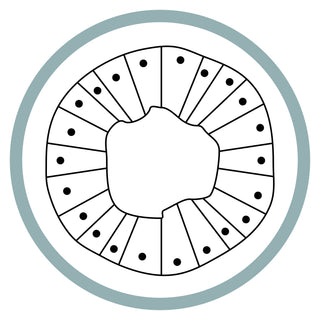Earthy tones have a unique charm that’s hard to replicate. These colours - ranging from warm beiges and sandy browns to olive greens and soft terracottas - instantly evoke a sense of calm and connection to nature. But their magic doesn’t stop at colour. When paired with natural materials, earthy tones can transform your home into a sanctuary that feels both grounded and timeless.
Let’s dive into why earthy tones and natural materials are a match made in design heaven and why they’re so deeply satisfying to incorporate into your home.
A Natural Connection to the Outdoors
Earthy tones draw their inspiration from the natural world. Think of the rich brown of tree bark, the muted green of moss, or the soft beige of sand. When you bring these colours into your home, you create a subtle yet powerful link to nature, helping to make your space feel organic and serene.
Pairing these tones with natural materials like wood, stone, jute, and clay amplifies this connection. A terracotta pot filled with lush greenery or a reclaimed wood coffee table not only looks beautiful but also evokes the calming rhythm of the outdoors. These elements work together to create an environment that feels restorative and timeless.
Warmth and Comfort
Earthy tones have an inherent warmth that makes spaces feel inviting and cosy. When combined with natural materials, this effect is heightened. A linen sofa in a warm taupe shade feels soft and breathable, perfect for relaxing. A wool rug in earthy hues not only adds texture but also wraps the room in a feeling of snugness.
The tactile nature of materials like rattan, bamboo, and cotton complements the visual warmth of earthy tones, making your home feel as comfortable as it is stylish.
Timeless Appeal
While colour trends come and go, earthy tones and natural materials remain timeless. They’re rooted in the enduring beauty of nature, which never goes out of style. A neutral beige wall or a terracotta accent vase feels equally at home in a modern minimalist apartment or a rustic farmhouse.
Natural materials, like oak or marble, age gracefully, developing a patina that adds character over time. Unlike synthetic materials, which can fade or feel outdated, these elements grow more beautiful with wear, making them a lasting investment for your home.
A Balanced and Harmonious Look
One of the most satisfying aspects of earthy tones is how effortlessly they blend with natural materials. A wooden dining table, for instance, pairs seamlessly with olive green chairs or a soft linen table runner. A stone accent wall looks stunning against a backdrop of sandy beige paint.
These tones and materials work together to create a harmonious, balanced look that feels both cohesive and serene. Even when layering textures - like a jute rug, a rattan pendant lamp, and a cotton throw in earthy shades - the overall effect remains calm and uncluttered.
A Sustainable Choice
Incorporating natural materials into your home not only enhances the aesthetic but also aligns with eco-conscious values. Choosing sustainably sourced wood, organic cotton, or handwoven jute rugs reduces your environmental impact while supporting ethical craftsmanship.
Earthy tones and natural materials encourage a mindset of intentional design- choosing pieces that last, both in style and durability. They remind us to value quality over quantity and to celebrate the imperfect beauty of handmade and natural items.
Enhancing the Emotional Feel of Your Home
Earthy tones and natural materials go beyond visual appeal -they influence how a space feels emotionally. A home styled with these elements is grounding, creating a sense of stability and peace.
Imagine curling up in a living room with clay-toned walls, a wool throw blanket, and the soft light of a rattan pendant lamp. The experience isn’t just about how the space looks; it’s about how it makes you feel - calm, comfortable, and deeply connected to your surroundings.
How to Incorporate Earthy Tones and Natural Materials in Your Home
Start Small:
- Add a woven jute rug to your living room.
- Place terracotta pots with greenery on shelves or window sills.
- Swap out synthetic décor for natural materials like wood or ceramic.
Experiment with Textures:
• Mix smooth stone surfaces with rough-hewn wood or soft linen.
• Layer a cotton blanket over a linen bedding for added depth.
Focus on Quality:
- Invest in durable, sustainable pieces that highlight the beauty of natural materials.
- Look for handmade items with unique textures and finishes.
Bringing Nature Indoors
Styling your home with earthy tones and natural materials creates more than just a beautiful aesthetic. It fosters a deeper connection to nature, a sense of warmth and balance, and a space that feels uniquely yours.
Whether it’s a rustic wooden coffee table, a soft linen duvet in a sandy shade, or hand-thrown ceramic dinnerware in muted clay tones, these elements bring the outside in - reminding us of the beauty and comfort that nature offers every day.
Are you ready to embrace earthy tones and natural materials in your home? Start with one or two elements and watch how they transform your space into a sanctuary of calm and timeless style.





